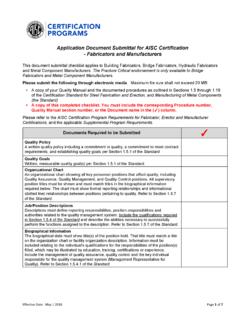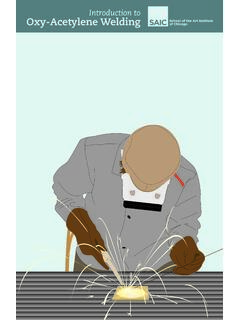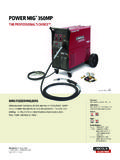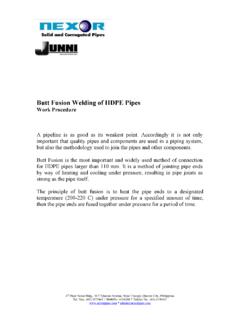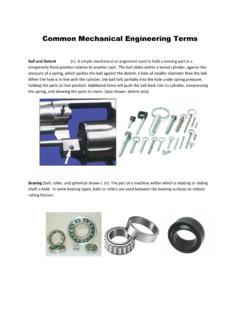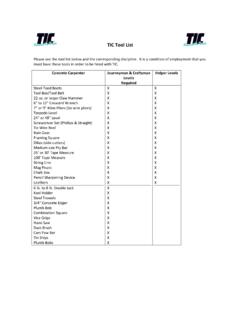Transcription of What Every Fabricator Wants You to Know about Welding
1 May 2008 MODERN STEEL CONSTRUCTION IWhat Every Fabricator Wants You to know about Weldingsteelwisemay 2008 There are plenty of things that engineers can do to make the welder s work easier and more o ur connection toideas + answersIF YOU aSKED ThE OpINION of a typical steel Fabricator , he or she would probably tell you that there should be a class (or two) in engineering and architecture curriculums that focuses on Welding and connection design from both the engineer s and the Fabricator s perspective.
2 However, there s simply no space in the typical curriculum for such a course. To help fill that need, we ve developed this article to cover several Welding design recommen-dations from the Fabricator s standpoint, including filler metal specifications, preferred weld types, and other applicable weld advice. Obviously we can t cover everything here, so refer to AISC s Design Guide 21, Welded Connections A Primer for Engi-neers; the American Welding Society 2006 Struc-tural Welding Code Steel (AWS :2006); and Section J2 of the AISC 2005 Specification for Struc-tural Steel Buildings for additional information.
3 When performed properly, Welding is an eco-nomical and efficient tool for joining steel. How-ever, Welding can become altogether uneconomi-cal when improperly specified. The skilled labor cost required to make a weld typically accounts for 75% to 95% of the total cost of a weld. Thus, cost-effective Welding is typically achieved when the required weld metal is deposited in the least amount of time. Here are some tips and highlights on how to design and specify economic processesIn total, there are approximately 100 different Welding processes.
4 At present, the steel construc-tion industry uses about five of them: shielded metal arc Welding (SMAW); flux cored arc weld-ing (FCAW), which can be gas or self shielded; submerged arc Welding (SAW); gas metal arc Welding (GMAW); and electroslag Welding (ESW). Design Guide 21 describes many of the pros and cons of the different types of Welding , as well as several process-specific Welding issues, such as applicability of low-hydrogen electrodes in SMAW; the conditions under which short-cir-cuit transfer may occur in GMAW; and the use of active fluxes in SAW.
5 The choice of Welding process can significantly affect the cost of a project. Typically, the contrac-tor makes this important decision, as he or she is usually best positioned to select the optimal weld-ing process for a given application. When properly used, all of the Welding processes listed in AWS are capable of delivering adequate welds for building construction. Over-use of CJp weldsIt is common knowledge that complete joint penetration (CJP) groove welds are typically the most expensive type of weld and thus should be reserved for situations in which they are the only viable option.
6 In a CJP groove weld, the full strength of the attached materials is developed. Thus, no design calculations are required when specifying CJP groove welds in statically loaded structures. However, this design advantage can be abused by specifying CJP groove welds in situ-ations where there are better, more economical options. The most commonly abused situation involves longitudinal welds on built-up beam and column sections. These welds are typically loaded in shear, which rarely requires the strength of CJP groove welds.
7 Fillet welds or PJP groove welds are typically better, lower-cost options for this case. Fillet and PJP welds are also typically the more environmentally friendly option, because deposit-ing less metal saves energy too!Fillet Welds vs. pJp Groove WeldsA helpful rule of thumb is to use fillet welds whenever the required weld leg size is 1 in. or less, and PJP groove welds or a PJP and fillet weld com-bination when larger sizes are required. Because most structural steel fillet welds are not required to have leg sizes greater than 1 in.
8 , fillet welds are typically the most economical choice, with the exception of skewed T-joints, which must be examined on a case-by-case basis. The table on the next page, taken from Design Guide 21, guides the user through an economical weld selection process based on loading and joint type. By monica Stockmann and thomaS J. SchlaflyMonica Stockmann is a Steel Solutions Center advisor, and Thomas J. Schlafly is director of research, both with STEEL CONSTRUCTION may 2008 Taking the Short Cut Specifying the Joint StrengthIn many cases, an alternative to specifying information in the weld symbol is to specify the required strength of the joint required.
9 The Fabricator will then design the weld to develop the strength specified as he or she sees economically fit, while still abiding by the design rules of AWS For example, a weld symbol without a dimension and without CJP in its tail designates a weld that will develop the adjacent base metal strength in tension and return or not to return?End returns, otherwise known as boxing, are the continuation of a fillet weld around the corner of a member as an extension of the primary weld.
10 End returns are used to ensure quality termina-tions to welds and to provide some resistance to prying of the weld roots. In general, end returns are neither prohibited nor required. AISC specification Section provides further discussion on the requirements and limitations for end returns. In statically loaded structures, fillet welds can be stopped short of the end of the joint by a length equal to the leg size of the weld, or continue to the end or be returned around the corner, except as noted in (1)-(4).





